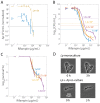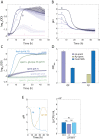Bacterial interspecies interactions modulate pH-mediated antibiotic tolerance
- PMID: 31995029
- PMCID: PMC7025823
- DOI: 10.7554/eLife.51493
Bacterial interspecies interactions modulate pH-mediated antibiotic tolerance
Abstract
Predicting antibiotic efficacy within microbial communities remains highly challenging. Interspecies interactions can impact antibiotic activity through many mechanisms, including alterations to bacterial physiology. Here, we studied synthetic communities constructed from the core members of the fruit fly gut microbiota. Co-culturing of Lactobacillus plantarum with Acetobacter species altered its tolerance to the transcriptional inhibitor rifampin. By measuring key metabolites and environmental pH, we determined that Acetobacter species counter the acidification driven by L. plantarum production of lactate. Shifts in pH were sufficient to modulate L. plantarum tolerance to rifampin and the translational inhibitor erythromycin. A reduction in lag time exiting stationary phase was linked to L. plantarum tolerance to rifampicin, opposite to a previously identified mode of tolerance to ampicillin in E. coli. This mechanistic understanding of the coupling among interspecies interactions, environmental pH, and antibiotic tolerance enables future predictions of growth and the effects of antibiotics in more complex communities.
Keywords: Drosophila melanogaster; Lactobacillus plantarum; antibiotic tolerance; ecology; gut microbiota; infectious disease; interspecies interactions; microbiology; rifampin.
© 2020, Aranda-Díaz et al.
Conflict of interest statement
AA, BO, RD, TT, ZH, ZG, WL, KH No competing interests declared
Figures













References
-
- Balaban NQ, Helaine S, Lewis K, Ackermann M, Aldridge B, Andersson DI, Brynildsen MP, Bumann D, Camilli A, Collins JJ, Dehio C, Fortune S, Ghigo JM, Hardt WD, Harms A, Heinemann M, Hung DT, Jenal U, Levin BR, Michiels J, Storz G, Tan MW, Tenson T, Van Melderen L, Zinkernagel A. Definitions and guidelines for research on antibiotic persistence. Nature Reviews Microbiology. 2019;17:441–448. doi: 10.1038/s41579-019-0196-3. - DOI - PMC - PubMed
Publication types
MeSH terms
Substances
Grants and funding
LinkOut - more resources
Full Text Sources
Other Literature Sources
Medical
Molecular Biology Databases

